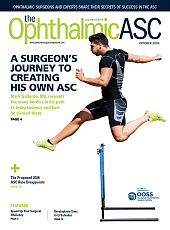A research team at the University of Colorado has developed a new AI-driven mathematical model to map the full course of geographic atrophy (GA), offering a tool that could refine the design of clinical trials and help clinicians predict patient outcomes more precisely.
The researchers created a “digital twin” for each patient—a personalized simulation based on early imaging data that predicts future lesion growth, explained Naresh Mandava, MD, who presented an overview of the process and findings at the 2025 American Society of Retina Specialists (ASRS) meeting in Long Beach, California. Their approach integrated deep learning image segmentation, validated against curated registry data, with Bayesian mathematical models, said Dr. Mandava, chair of the department of ophthalmology at the University of Colorado Anschutz Medical Campus. Their data suggest that GA lesion growth is neither linear nor indefinite, but instead follows a multiphase course, with periods of acceleration, linear expansion, and deceleration ending in an asymptote, or plateau.
“We basically developed an AI-assisted mathematical modeling for geographic atrophy,” Dr. Mandava said. “We have a registry of over 2,000 patients with age-related macular degeneration followed for up to 12 years. That allowed us to build a model of lesion growth over the entire life cycle, something that hasn’t been done before. We saw patterns that we had not seen reported.”
A Data-Rich Approach
The modeling relied on 2 major data sets: the Colorado AMD Registry, a longitudinal data set containing imaging, clinical, and biomarker data; and CORIS, a larger but less structured data set of all patients seen in the eye center since 2012. Using the registry, the team trained and validated an AI tool to automatically segment and register GA lesions from fundus autofluorescence images across multiple visits.
The Eyeliner Pipeline, developed in-house, enables multimodal registration of these images over time, correcting for differences in tilt, illumination, and field of view.1 An AI annotation tool, OPTIMEyes,2 facilitated development of the segmentation model. The final segmentation model achieved a DICE coefficient of 0.91 and showed strong correlation (r=0.99) with manual measurements.
“Our deep learning GA segmentation was validated using the highly curated AMD registry that had manual measurements for the first and last visit,” Dr. Mandava said. “This allowed us to build confidence in the automated lesion area calculations over time.”
Toward a New Growth Model
Conventional studies of GA, including most clinical trials, have often assumed a linear or equivalent radius (proportional to square root of area) growth pattern of lesions. But using the AI-powered platform to analyze patients with at least 5 high-quality imaging visits over up to 15 years, the researchers observed consistent nonlinear growth. Instead, the real-world data showed that lesion expansion typically followed a curve with an early acceleration phase, a middle linear phase, and a late deceleration phase culminating in a plateau.
The team tested various mathematical models, including linear, square root, logistic, and perimeter-based growth. Ultimately, they found that a Gompertz curve best represents the progression of GA because it captures the 3 distinct phases of GA growth, said Dr. Mandava: “Initiation with almost exponential growth, linear growth, and then a reduction in growth rate leading to an asymptote for lesion size.” This model outperformed linear approaches, especially in predicting long-term lesion size.
This shift in understanding has direct implications for clinical trial design. One of the most important findings is that lesion growth is bounded. “Lesions don’t just keep growing indefinitely,” Dr. Mandava said. “In most patients that we observed for sufficiently long times, we saw that the growth rate slowed down substantially, but at different levels. [GA cases] reach an asymptote and kind of burn out.”
A significant proportion of patients enrolled in clinical trials for GA therapies may already be at or near their asymptotic limit, said Dr. Mandava. In studies with inclusion criteria extending to lesions up to 17.5 mm2, over one-third of participants may have already begun to naturally plateau. This could create a misleading impression of an investigational therapy’s effectiveness and obscure outcomes. Enrolling patients in the linear growth phase is likely to yield clearer treatment effects, said Dr. Mandava.
Clinical Implications
The research also calls into question the use of fellow eyes as controls in early phase trials. According to Dr. Mandava, using an untreated eye as a control can introduce serious bias if the eyes are at different phases of the GA lifecycle.
“If the fellow eye is in the acceleration phase and the treated eye is at its asymptote, it may falsely appear that the treatment worked,” he said. “You probably want to pick patients with similar area of atrophy in both eyes for early phase trials.”
For practicing clinicians, the tool has potential in real-world patient management as well. The ability to identify whether a lesion has reached its growth plateau may help in deciding whether continued treatment is warranted. “In the clinic, we hope a physician can look at a patient with early GA in one eye and advanced GA in the other and say, ‘You’re not going to get worse in this eye; you’ve reached the asymptote,’” Dr. Mandava said. “And the other eye, we should treat.”
Although the full mathematical method and statistical details are pending publication, the team intends to publish soon. Dr. Mandava noted that the research team includes a dozen data scientists and AI specialists, led by Jayshree Kalpathy-‑Cramer, chief of artificial medical intelligence in the department of ophthalmology at the University of Colorado Anschutz Medical Campus. RP
References
1. Veturi YA, McNamara S, Kinder S, et al. EyeLiner: a deep learning pipeline for longitudinal image registration using fundus landmarks. Ophthalmol Sci. 2024;5(2):100664. doi:10.1016/j.xops.2024.100664
2. McNamara S, Bearce B, Kinder S, et al. OPTIMEyes: an annotation and inference feedback tool for multimodal ophthalmic imaging. Invest Ophthalmol Vis Sci. 2024; 65(7):2377.








